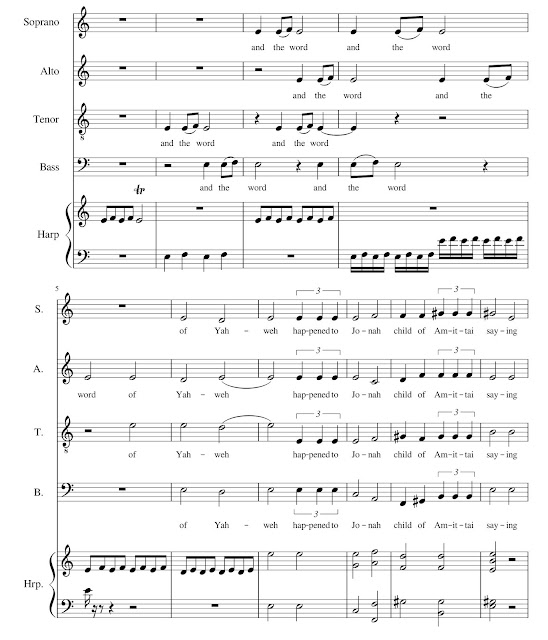The possibilities are endless. You can hear Jonah (development described below) just less than 20 minutes in total, here on my YouTube channel. The full score is in a printable format in the prior post here. [I put this at the top since many of you won't get to the bottom and you will miss the treat!]
The raw data I have chosen for this example is Jonah 1:1 and Jonah 3:1.
וַֽיְהִי֙ דְּבַר־יְהוָ֔ה אֶל־יוֹנָ֥ה בֶן־אֲמִתַּ֖י לֵאמֹֽר
Jonah 1:1 Note the accents: They translate into the music. e qad,z-q,f g# e (qad = qadma, z-q = zaqef qatan)
Here is the verse in its raw form. (All scores in music XML are available as noted above, so you can import them into any music program like Musescore for your own development. I highly recommend this program.) What will we do to them as arrangers / composers?
 |
| Jonah 1:1 interpreted through the deciphering key of Suzanne Haïk-Vantoura |
The accents above the text (two of them above), indicate an ornament. The accents below the text (three of them above) indicate a change in reciting note. There is an accent on the first syllable that is not highlighted. It is the default starting pitch but here represents the emphasis on the first syllable: in English And.
It's the beginning of the book of Jonah, why would one emphasize the first syllable?
וַיְהִ֧י דְבַר־יְהוָ֛ה אֶל־יוֹנָ֖ה שֵׁנִ֥ית לֵאמֹֽר
 |
| Jonah 3:1 interpreted through the deciphering key of Suzanne Haïk-Vantoura |
I have made a number of choices. First when the Lord speaks or acts, I have signaled it with a trill in the accompaniment. The trill is suggested by the initial ornament. I have also used the 'sound of many waters' or multiple voices for the word of Yahweh. No soloist here.
Jonah 1:1 turns into a grand opening, (noting the accentuation of the first syllable):
 |
| Composing to Jonah 1:1 |
Jonah 3:1 is quite different, though the trill is still there as a signal.
 |
| Jonah 3:1 after some arrangement of the melody. |
The wider interval in the harp indicates the movement of the sea as heard in Jonah 2. The harp is an important interpreter. As Psalm 33 instructs, Give thanks to Yahweh on the harp. Here is a part of a chorale I have started to work on.
 |
| Psalm 33:2 , Give thanks to Yahweh on the harp. |
I see that Wikipedia reports that Haïk-Vantoura's
"reconstruction assumes the signs represent the degrees of various musical scales, that is individual notes, which puts it at odds with all existing traditions where the signs invariably represent melodic motives; it also takes no account of the existence of older systems of notation, such as the Babylonian and Palestinian systems. Musicologists have rejected her results as dubious and her methodology as flawed."The rejection they note is c 1986. I didn't come across this opinion in my research. It might have turned me off all my consideration of her deciphering key. I will only judge and be judged by the result of the transcriptions. And they are often magnificent. This is not a dubious statement. They are undoubtedly magnificent.
There are issues, but the musicologists I have reviewed dismiss the whole interpretation in a sentence and have not worked within the framework for 10 years as I have. And it takes years to hear what is going on.
No one knows what the music sounded like, but at least one could use the data that is evident. Haïk-Vantoura's key uses the placement of the accents like no other. She follows the rule of Occam's razor.
Certainly, one of the issues is sameness within the harmonic patterns. How often can you set e-b-a to music and remain interesting? But one only needs to study the Goldberg variations to know how to deal with sameness in composition.